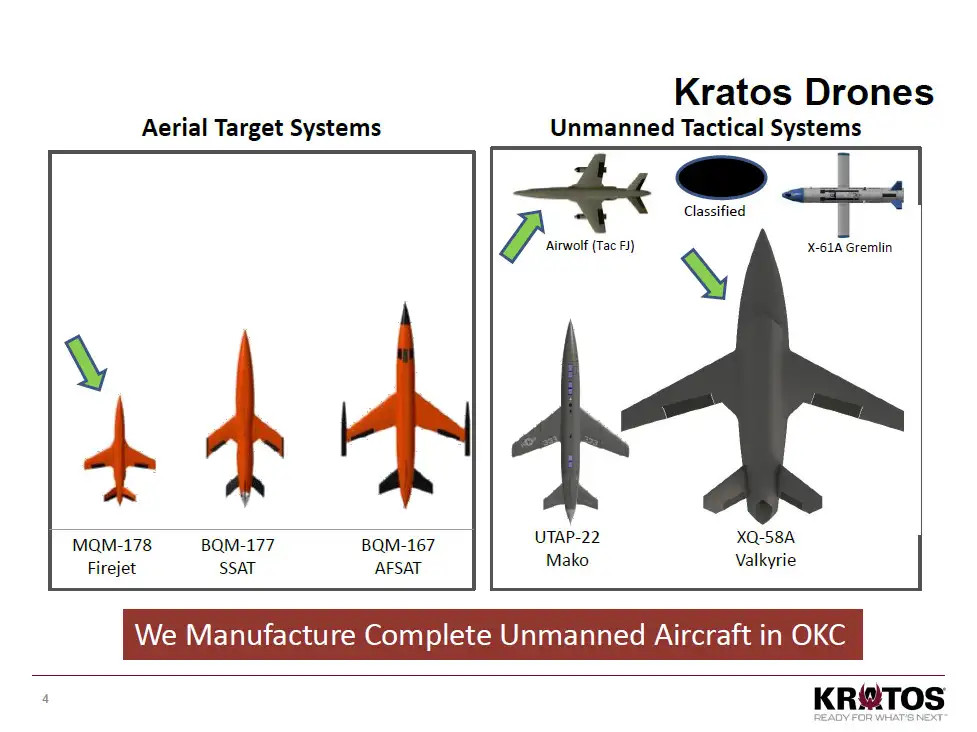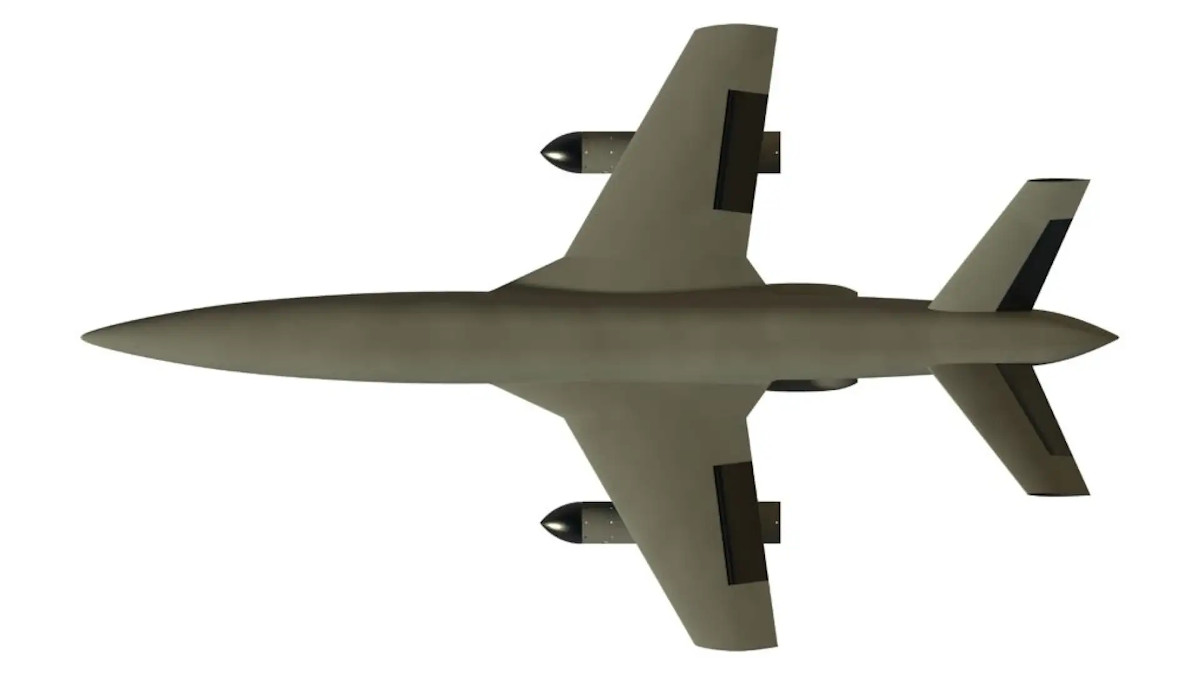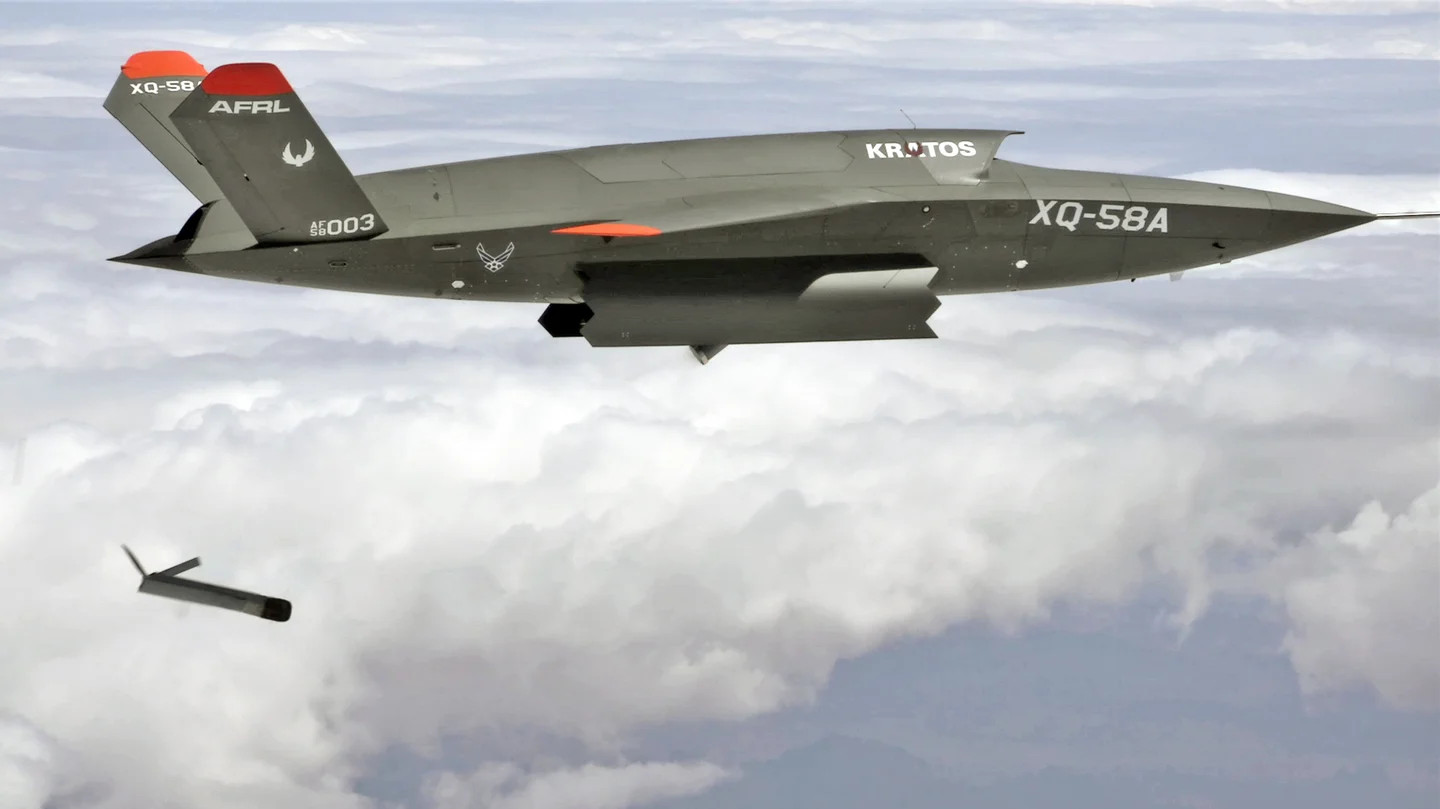Kratos has demonstrated the ability of its Airwolf unmanned aircraft to air-launch an AeroVironment Switchblade loitering munition, also commonly referred to as a “suicide drone.” This test has opened up a significant new “opportunity space” for how Airwolf, which is derived from its MQM-178 Firejet aerial target, could be employed operationally. The company has only given out relatively limited details about Airwolf, which is the smallest and cheapest of its publicly disclosed tactical designs, in the past and just released its first picture of one of these drones earlier this month. You can read more about what we had already been able to glean about this drone here.
Steve Fendley, President of Kratos’ Unmanned Systems Division, confirmed to The War Zone that the Switchblade test had occurred “a number of months ago,” on the sidelines of the Air Force Association’s annual Air, Space, and Cyber Conference yesterday. He also provided other details about Airwolf, which has also been referred to in the past as Tactical Firejet. Fendley said the company is currently “on contract” to provide Airwolfs for “different customers,” which he could not name, configured for surveillance and target acquisition mission sets, as well as what he described as “offensive support.” That latter category would seem to include the ability to launch Switchblades.

“It’s a very interesting capability,” Fendley said of the Switchblade test, specifically. “It’s a high-performance UAV [unmmanned aerial vehicle] launching another, what’s called a strike munition, which is a separate aircraft.”
Airwolf, like the MQM-178, is a relatively small, jet-powered drone that is launched from the ground via a catapult system. The two designs have the exact same outer mold line, according to Fendley, which means they both have an overall length of just under 11 feet and a wingspan of around six and a half feet. Airwolf obviously has different avionics and the ability to carry different payloads to perform tactical missions rather than act as a target like the MQM-178.
Standard Firejets, which have a maximum takeoff weight of close to 320 pounds, are used to help train fighter pilots and ground-based air defense personnel, as well as support various research and development and test and evaluation activities.

Firejet’s performance is “very much in the conventional subsonic fighter jet flight envelope” with its jet performance and the speed, and the ability to fly up to 35,000 feet,” Fendley added. “Obviously, it’s a bit lower performance, [and] doesn’t have the same endurance or payload capacity as our largest tactical system, the [XQ-58A] Valkryie.”

Switchblade is a very small, tube-launched unmanned system that was originally developed to be carried and employed by a single individual on the ground. It is a loitering munition, or suicide drone, a category of systems that blend together capabilities that are typically found on either unmanned aircraft configured for intelligence, surveillance, and reconnaissance (ISR) missions or missiles, but not both.
The video below shows a multi-cell launch system AeroVironment developed for the Switchblade, underscoring how small a launcher for one of these loitering munitions can be.

Switchblade can be used to scout ahead or conduct other kinds of short-duration surveillance missions using its combination of electro-optical and infrared cameras, but also has a small warhead, giving the operator the option to immediately strike any targets that it might come across. This loitering munition has certain autonomous capabilities, including the ability to automatically navigate to a designated target and follow it if moves, but it can also be employed in a manually-controlled mode. It can also be directed to strike a specific fixed area using GPS coordinates. You can read more about Switchblade’s capabilities in this past War Zone feature.
No matter what, the operator remains in the loop throughout the course of a mission. This gives Switchblade a high degree of precision when used to strike a target, as the user, who “sees” what the drone sees through the feed from its cameras, can make minor course adjustments right up until the moment of impact. This also provides an additional margin of safety, since the person at the controls is monitoring the situation and can “wave off” the munition almost at the last moment should circumstances change, such as the sudden appearance of innocent bystanders in the target area.
It’s not clear how the Airwolf was configured to launch the Switchblade. Artwork that Kratos, as well as its subsidiary 5-D Systems, has released in the past shows that Airwolf, like the MQM-178, can be configured to carry small stores under its wings. Switchblade is also small enough that its launcher could have been integrated into the Airwolf’s fuselage, as well.

Kratos’ Fendley did make clear that the Airwolf-launched Switchblade retained its operator-in-the-loop capability during the test. The feed from the suicide drone was relayed back to the user through a datalink on the Airwolf. That link also points to the potential use of this drone as a communications relay node, as well as its general ability to feed information to other assets, manned or unmanned, in the air or down below.
All told, the pairing of Airwolf and Switchblade sounds like a very lethal combination. Fendley specifically highlighted how the Airwolf’s range, which he could only say was in the “many hundreds of nautical miles,” helps “extend the terminal utility range of that Switchblade by orders of magnitude.” Switchblade can only stay aloft for around 15 minutes and has a maximum range in its ground-launched configuration of just over six miles, which would be substantially increased when employed in an air-launched configuration.
“It substantially obviously increases your stand-off position, which is ultimately the point for the unmanned systems anyway, keep the humans safe,” he added. “Nothing does it better than increasing your stand-off position by 10x.”
Fendley pointed out that this isn’t the first time Kratos has demonstrated the ability of one of its drone designs to launch a smaller unmanned aircraft. In December 2020, the company, in cooperation with the Air Force, conducted a separate test that saw a stealthy XQ-58A Valkyrie drone launch an Area-I ALTIUS 600 from a launcher in its internal payload bay.

With regards to Airwolf, Kratos has separately demonstrated its ability to operate with a high degree of autonomy. That and other capabilities, combined with the low cost of each one of these tactical drones, makes the design “directly applicable to swarm missions” and “the manned-unmanned teaming realm,” Fendley said. Speaking “in general terms,” he said that Airwolf’s unit cost was under $500,000, though this price point would, of course, be dependent on the exact configuration of the drone. Even at $500,000, Airwolf is significantly cheaper than many stand-off air-to-ground munitions, as well as air-to-air missiles.
Swarms are inherently ideal for overwhelming and otherwise disrupting enemy forces, especially air defense networks. A swarm of Airwolfs that then releases a large number of Switchblades over a target area would only add to this underlying capability. That same swarm could also include Airwolfs configured for general ISR or optimized for target acquisition, information that could then be used to target Switchblades. Some of the drones could also be configured to carry other payloads, such as electronic warfare jammers.
When asked about whether any work was being done to adapt Airwolf into an air-launched configuration Fendley could only say “no comment.” He also could provide no additional information on separate testing of Kratos’ UTAP-22, also known as the Mako, a “loyal wingman” drone derived from the larger BQM-167 target drone, in an air-launched configuration.
Being able to air-launch Airwolfs, potentially carrying Switchblades inside, from a larger manned or unmanned platform would only increase their ability to reach deeper into enemy territory or extend the time they would be able to loiter over a particular part of the battlespace. It would also bring totally new tactical opportunities to the launch platform.
All told, the more we learn about Kratos’ Airwolf, which is currently the lowest, most affordable known tier of the company’s tactical offerings, the more intriguing the design becomes. The Switchblade test only underscores the already emerging versatility and flexibility of this relatively high-performance and low-cost platform.
Contact the author: joe@thedrive.com
